Drugs
LSD Dangers: The Hotdog
Posted By: Paul - Sun Jun 09, 2024 -
Comments (1)
Category: Anthropomorphism, Death, Drugs, Psychedelic, Food, PSA’s, 1960s
The 1967 Human Be-In
The Wikipedia entry.


Posted By: Paul - Fri May 03, 2024 -
Comments (0)
Category: Ceremonies, Drugs, Parades and Festivals, Bohemians, Beatniks, Hippies and Slackers, 1960s
Device to self-administer gas
This curious device was featured in Mechanix Illustrated (July 1938), but no info was given about the inventor.
So I searched the patent archive. This patent granted to Justin Sholes in 1939 seems to be it:

Posted By: Alex - Thu Apr 25, 2024 -
Comments (2)
Category: Drugs, Patents, 1930s
Unauthorized Dwellings 33
Read the full story here.NOTE: image is generic.
A man in Washington smelled cigarette smoke in his home and traced it to an upstairs loft. There he found a makeshift bed, a running heater, half-eaten food, and drugs. The following day the suspect returned to the house and was taken into custody, police said.

Posted By: Paul - Wed Apr 17, 2024 -
Comments (3)
Category: Drugs, Stupid Criminals, Unauthorized Dwellings, Twenty-first Century
Is it marijuana or alfalfa?
Peter Hlookoff had an unusual strategy to avoid being convicted for possession of marijuana — he always carried a container of alfalfa with him.His reasoning was that alfalfa and marijuana smell similar (so he claimed). So if the police ever arrested him for possession of marijuana he could claim that it was actually alfalfa they had smelled (or seen him smoking).
This strategy was put to the test in Dec 1967 when the police raided his apartment and arrested him for smoking pot. During the subsequent court case his defense led to the magistrate arranging for a court employee to smoke marijuana so that its smell could be compared to alfalfa.

Victoria Times Colonist - May 10, 1968
Unfortunately the courtroom experiment was cancelled before it took place, and the magistrate ended up finding Hlookoff guilty. He didn't buy Hlookoff's follow-up argument that if, perhaps, it had been marijuana he was smoking then someone must have (without his knowledge) put marijuana in his alfalfa container.

The Vancouver Province - July 3, 1968
Hlookoff's roommate, Marcel Horne (a professional firebreather whose stage name was 'El Diablo'), later wrote an autobiography in which he revealed that, yeah, they were absolutely smoking pot when the police raided their apartment:
We were rapping away very stoned, when we heard someone coming up the stairs. The next thing we knew two cops in uniform walked into the room. Peter tried to drop the roach but the cop saw him. I was too stoned to think properly so I just lay there watching the nightmare. The cops put us up against the wall and frisked us. "Who does the marijuana belong to?" We both answered, "What marijuana?"

image source: Annals of the Firebreather (1973), by Marcel Horne
Posted By: Alex - Wed Mar 27, 2024 -
Comments (2)
Category: Drugs, Smoking and Tobacco, Law, 1960s
The Judge who wanted to be fully informed
Nov 1976: Roxbury District Court Judge Elwood McKenney, presiding over a cocaine possession case, announced that he would need to try cocaine himself before he made his ruling... in order to be able to make an informed decision. He recessed the trial until he had done so.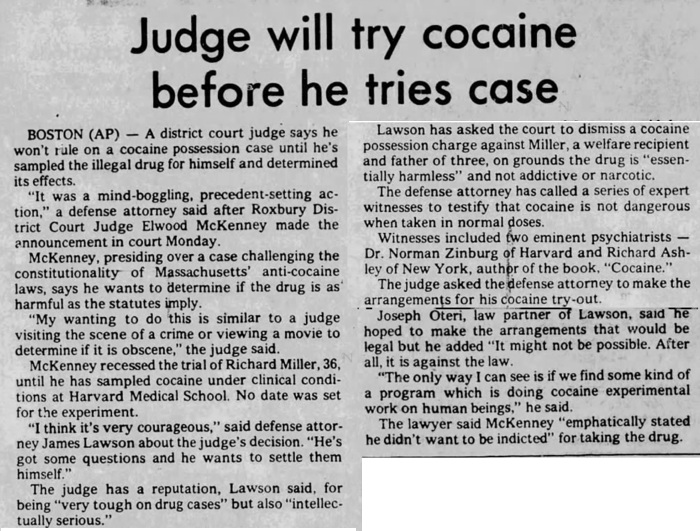
Palo Alto Times - Nov 2, 1976

Judge Elwood McKenney
About a month later, McKenney abandoned his decision to try cocaine, saying that all the publicity about it had distorted his intent.
But he then proceeded to rule that the Massachusetts statutes forbidding the possession of cocaine were unconstitutional.
Obviously his ruling must have been dismissed or overturned at some point, otherwise cocaine would now be legal in Massachusetts. But I haven't been able to figure out when that happened.
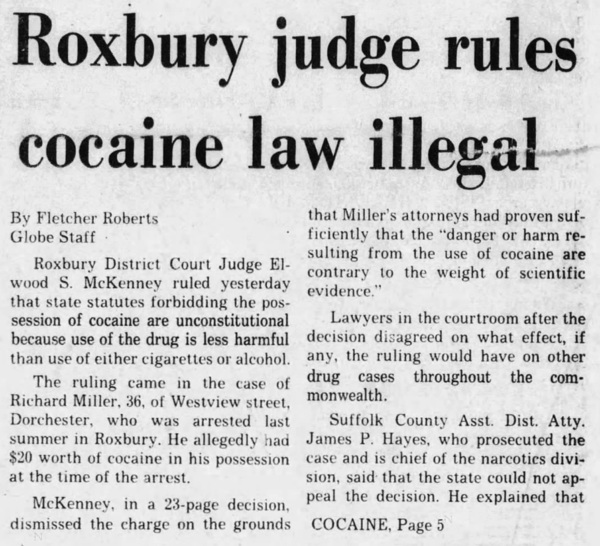
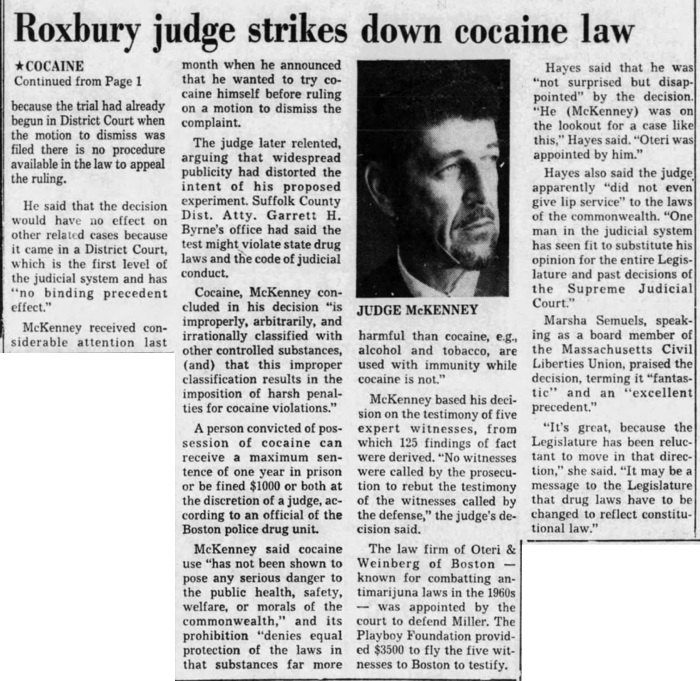
Boston Globe - Dec 11, 1976
Posted By: Alex - Thu Jan 18, 2024 -
Comments (1)
Category: Drugs, Law, Judges, 1970s
Follies of the Madmen #583
In 1969, everything had to relate to drugs.Source.

Posted By: Paul - Tue Dec 05, 2023 -
Comments (0)
Category: Drugs, Food, Advertising, 1960s
Cocoaine for the hair
I'm sure cocaine would soothe an irritated scalp, but I can't imagine why it would cure dandruff.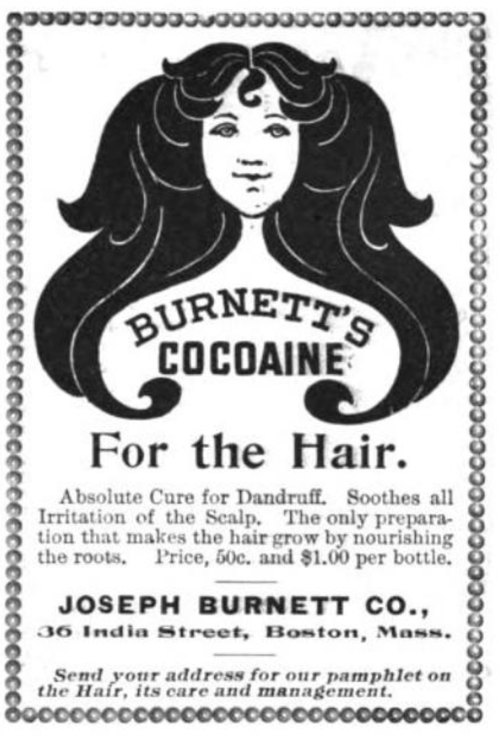
Posted By: Alex - Sun Jul 30, 2023 -
Comments (2)
Category: Drugs, Nineteenth Century, Hair and Hairstyling
The Jackson Illusion Pepper
The 1960's fad for smoking banana peels is well known. Less well known is a similar late-60s drug fad called the "Jackson Illusion Pepper." An explanation from Drugs From A to Z: A Dictionary by Richard R. Lingeman (1969):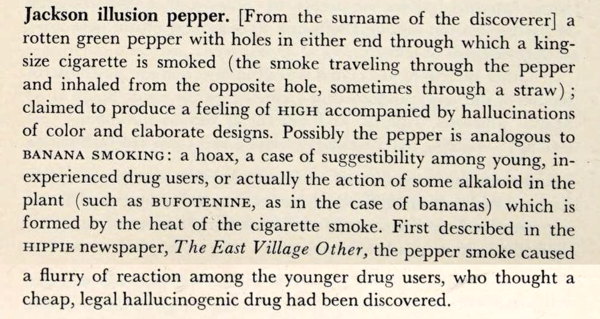
More info from The East Village Other (Apr 1-15, 1967):
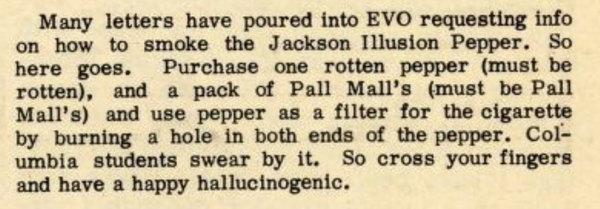
Posted By: Alex - Sat Jul 22, 2023 -
Comments (1)
Category: Drugs, Smoking and Tobacco, 1960s
Merck satisfies your growing appetite for MSG
A full plate of MSG, but you already need more... MORE!Never fear, "You can depend on Merck for unlimited quantities of MSG." In Crystal or Fine Crystal form.

Food Technology - Sep 1958
Posted By: Alex - Fri Jan 06, 2023 -
Comments (1)
Category: Drugs, Food, Advertising, 1950s

| Who We Are |
|---|
| Alex Boese Alex is the creator and curator of the Museum of Hoaxes. He's also the author of various weird, non-fiction, science-themed books such as Elephants on Acid and Psychedelic Apes. Paul Di Filippo Paul has been paid to put weird ideas into fictional form for over thirty years, in his career as a noted science fiction writer. He has recently begun blogging on many curious topics with three fellow writers at The Inferior 4+1. Contact Us |




